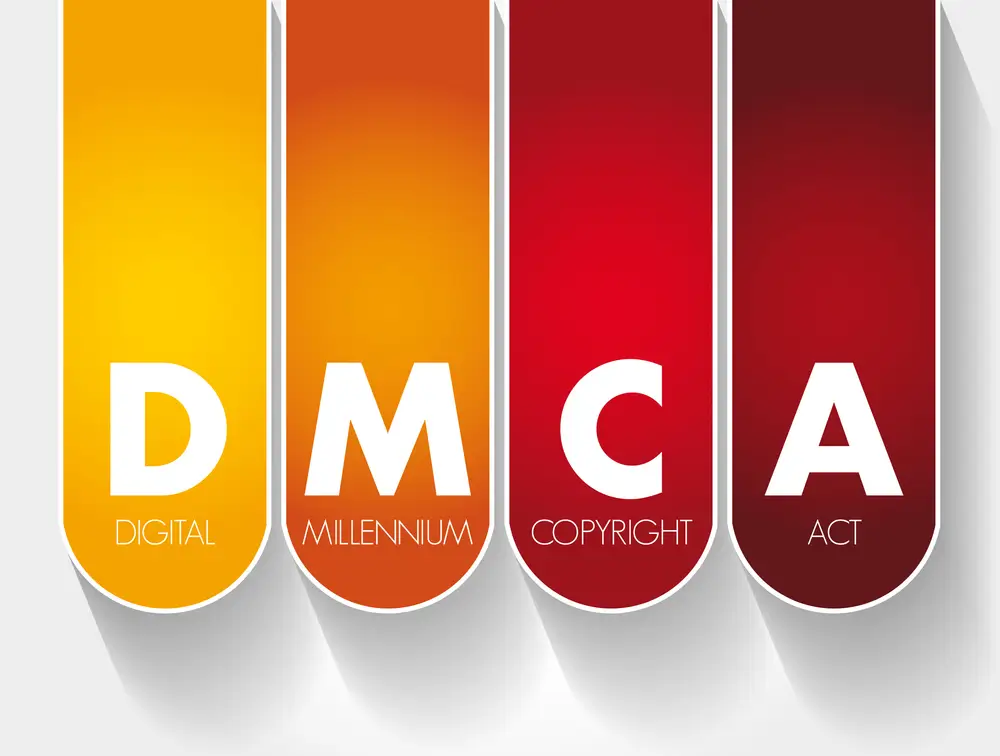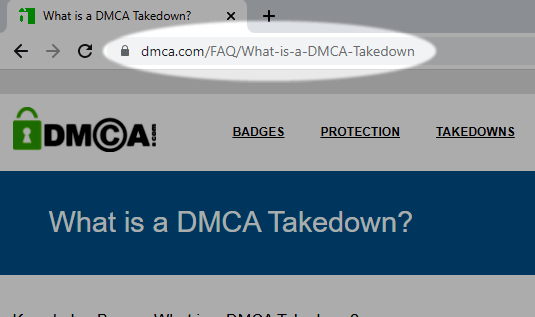
A DMCA Takedown Notice is a type of legal document which lays out how two parties can handle the theft and subsequent online publication of copyrighted content or copyright infringement. A DMCA Takedown Notice gets its name from a section of the US Copyright Act called the Digital Millennium Copyright Act (DMCA). The DMCA specifically addresses copyright violation and enforcement over the internet.
This legal document is generally delivered to website owners, ISP's/ OSP's, Hosting Companies, UCG platforms or individuals illegally (re)publishing content without the permission of the (copyrighted) content owner. The document stipulates the content that has been stolen and republished without permission with a request for removal. It must be created and submitted in a specific manner so as to comply with the law. Failure to do so means the "notice" to remove the content will not be followed by any party involved in the copyright infringement.
In exchange for the immediate removal of the content the publisher receives safe harbor from litigation regarding the illegal publication of copyrighted content.
Click here to Start Your Takedown
DMCA Takedown Fast Tip
Takedown actions occur upon receipt of a DMCA Takedown Notice which uses stipulations laid out in the Digital Millennium Copyright Act. (DMCA). This Act directly addresses the takedown of (copyright) infringed content from a website which is publishing content in violation of the copyright protection act or content being used without permission or not in accordance to the sworn statement of the content owner. There are many ways content may be removed but the process starts with a DMCA Takedown Notice.
What do I need to file a DMCA Takedown Notice?
Three pieces of information are needed to start filing DMCA Takedown Notice:
1. Infringing (Stolen) URL(s)

Questions to answer when providing the stolen picture links:
- Where on the internet is your stolen picture located?
- What is the link that you want the picture removed from?
- Was it on a social media website?
Be sure to provide the exact image link you want taken down.
An example link would look like: https://www.badguy_site.com/webpage/image_2

2. Source (Original) URL(s)
Questions to answer when providing the original pictures:
- Where was the picture located when it was stolen?
- Was it from your own website?
- Was it on your social media profile?
Be sure to provide the exact URL where it was stolen from, even if the picture has already been removed from its original location. The original URL is still valuable to the notice. If it was not online you can reference cell phone, computer, or camera etc. If it was online such as a website or cloud storage provide the link to the exact page it was stolen from. You can upload the original content to a cloud storage service and provide that URL with an explanation of where it was originally stolen from.
3. Description of Ownership (What Happened)

Questions to answer when writing out the description:
- Who is authorized to file the DMCA Takedown?
- What is the picture owner's name and how was the picture stolen?
- Who is claiming ownership of the picture?
- How is this picture yours?
- How do you own the picture?
- Did you copyright it, create it, buy it?
- When did you create the picture and when was the picture stolen?
An example description would sound like: "My picture I took of myself on my camera was stolen from my Google Drive and was posted on this website without my knowledge and I would like it removed."
If you are unsure how to collect the information for these three categories the Professional Takedown Team at DMCA.com can help with the answers. Click here to ask us about your situation.
DMCA Takedown Testimonial
Thank you DMCA.com and Staff for successfully removing images that violated my copyright and privacy. I was the victim of theft and my pictures were hosted online without my permission. DMCA.com successfully had the images removed within 3 days of completing my request and I will definitely be using their services again, if needed! THANK YOU SO MUCH!!!!!****
Do all websites have a DMCA Takedown Notice process?
No. If a website does not clearly state they follow DMCA you can still process a DMCA Takedown Notice to remove your stolen content. There can be many reasons a website does not reference the DMCA directly.
How can I tell if a website has a DMCA Takedown Notice process?
If a website uses the DMCA they will usually place a reference in the footer of the website. The clickthrough should clearly state the conditions of the DMCA Takedown process. Many websites reference the DMCA.com Takedown Notice form on this website directly. If you are unsure or the website unclear, click here to complete your takedown request: DMCA Takedown Form. Our professional team will connect your takedown request to the right website.
How can I add a DMCA Takedown Notice Policy to my website?
DMCA.com's first recommendation is to contact a lawyer or law firm in the legal jurisdiction of your company or website to determine what is the appropriate legal communication. DMCA.com does not offer any legal advice or specific recommendation regarding any copyright practice.
DMCA.com has two programs to help content creators, publishers and UGC platforms:
- Content Publishers or Platforms of User Generated Content (UGC) should use the DMCA Compliance program - Get Compliant - adding a compliance badge to your site instantly takes the guess work and time out of processing DMCA Takedown notices on your site.
- Content Creators and Publishers (without UGC) should use DMCA.com Protection Pro - Content Protection - it is essential to add an ownership statement to all your content. Registering and adding your content and website to this program is click through easy. There is even a Free program so getting started is easy.
Is DMCA Takedown Notice only used in the USA?
The DMCA Takedown process described within the law is widely used throughout the world. While the DMCA is part of USA Copyright Law. Most countries accept the standard DMCA Takedown Notice form and process. Although the DMCA Takedown is part of US Copyright law, a DMCA Takedown Notice is often used and accepted throughout the world and not exclusive to the United States. However, many countries have their own copyright laws specifically related to the removal of content from internet service providers and site owners within their borders. Which service providers do and do not accept the standard DMCA takedown notice form and process is dynamic and constantly changing. DMCA.com professionals are aware of these constant changes and are able to convert the information submitted through the standard DMCA Takedown signup form to suit specific countries and/or service providers within the legal process they require.
Related DMCA Takedown FAQ's
- What is DMCA
- What is the DMCA Protected Badge

- What is DMCA Protection
- What is DMCA Takedowns
- What is DMCA.com
- What is DMCA Protected Certificate
- What is DMCA Website Certificate
- What is DMCA Website Status Page and Protection Certificate